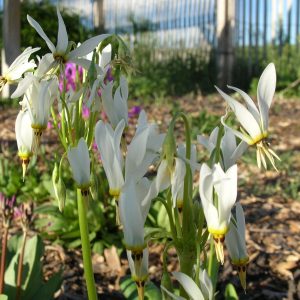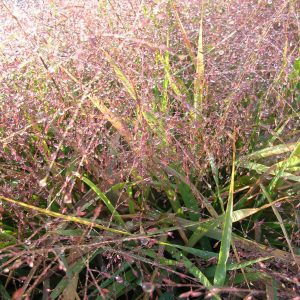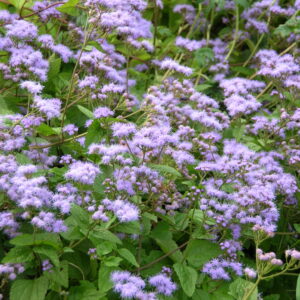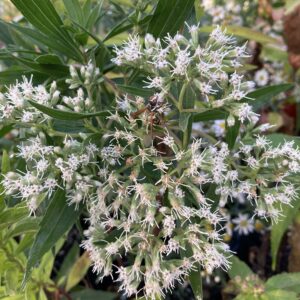Prairie Plants
Showing 33–40 of 85 results
-
Dodecatheon meadia syn. Primula meadia Shooting Star Z 4-8 Ephemeral
White reflexed flowers, looking like a descending shuttlecock, dangle from stems in spring. Ephemeral.
Available to order in Spring only
White reflexed flowers, looking like a descending schuttlecock, dangle from stems in spring. Ephemeral.
Size: 12” x 6”
Care: part shade in moist well-drained soil.
Native: PA to Wisconsin, south to TX.
Awards: England’s Royal Horticultural Society Award of Merit.Dodecatheon from the Greek dodeka (twelve) and theos (gods), meaning 12 superior gods, after the name given to another plant by Roman author, Pliny the Elder. The species name meadia after Richard Mead, physician to English King George III. John Tradescant the Younger sent this to England by 1640. “A favorite among old border flowers.” William Robinson, 1899.
-
Echinacea pallida Pale purple coneflower Z 4-8
Narrow, weeping pink rays in early to mid-summer surround its coppery-orange, hedgehog-like cone.
Narrow, weeping pink rays in early to mid-summer surround its coppery-orange, hedgehog-like cone.
Size: 2' x 14"
Care: Full sun in well-drained soil. Drought tolerant.
Native: much of continental US east of Colorado
Wildlife Value: deer resistant. Nectar feeds butterflies and hummingbirds. Birds eat seeds
Awards: Great Plants for Great PlainsEchinacea is Greek meaning hedgehog referring to the bristly conehead. Used to cure many ailments – arthritis, rheumatism, burns, colds, boils, fever, sore mouths, throats & gums, toothaches, snakebites, headaches, stings and distemper in horses – by several tribes – Cheyenne, Crow, Dakota and Sioux. 1st collected by English planthunter Thomas Nuttall (1786-1859) in Arkansas. Nuttall searched entire No. American continent, parts of Canada, from New England west to Oregon, the South, Midwest, the Plains, the S.E., California & Hawaii finding thousands of new plants.
-
Eragrostis spectabilis Purple Love grass Z 5-9
Profuse tiny purple panicles in August-September. One of internationally known garden designer Piet Oudolf’s 100 “MUST HAVE” plants, Gardens Illustrated 94 (2013)
Profuse tiny purple panicles in August-September. One of internationally known garden designer Piet Oudolf’s 100 “MUST HAVE” plants, Gardens Illustrated 94 (2013)
Size: 2’ x 18”
Care: Full sun in well-drained soil - slow to emerge in spring. Drought tolerant
Native: Maine west to Minnesota, south to Arizona, Wisconsin nativeEragrostis is Greek meaning “love”, (eros) and grass, agrostis. This species first named by German botanist Frederick Pursh (1774-1820) in his book Flora Americae Septronalis. (1813)
-
Eryngium yuccifolium Rattlesnake master Z 3-8
Blooms July-December, prickly round white umbels. Leaves like thinner versions of a Yucca.
Blooms July-December, prickly round white umbels. Leaves like thinner versions of a Yucca.
Size: 48” x 18”
Care: Full sun, moist well-drained soil
Native: Eastern United States, Wisconsin native
Wildlife Value: Supports over 40 bee species.
Awards: Missouri Botanic Garden Plant of Merit.Eryngium is Greek meaning “thistle.” The name “Rattlesnake master” comes from the use by Chickasaw shamans of chewing the root, blowing it on the hands and then picking up rattlers without injury or “from its virtues of curing the bite of that venomous reptile.” Gardeners’ Dictionary, 1768. Valued by Native Americans for medicinal uses: a diuretic, stimulant, and cure for venereal disease and impotence, purify blood; Chippewa for joint inflammation and strengthen young children and Cherokee as a toothache remedy; Sioux: Root cured bladder ailments, and rattlesnake bites and scorpion stings. A concentration of boiled root increased virility of Sioux men. The Forest Potawatomi used Rattlesnake master as a good luck charm – the top placed in a pocket made the gambler sure to win. Collected in Virginia by Rev. John Banister (1649-1692) who moved to colonial Virginia in 1678. A gunman mistakenly shot and killed him while he collected plants.
-
Eupatorium coelestinum syn. Conoclinium coelestinum, Coelestina ageratoides Blue mist Z 3-7
Clusters of cornflower blue in fall –close looks like a mophead of many strings, at a distance it looks like a big Ageratum - August to October.
Clusters of cornflower blue in fall –close looks like a mophead of many strings, at a distance it looks like a big Ageratum – August to October.
Size: 3' x 2-3'
Care: full sun in moist to moist well-drained soil.
Native: New Jersey west to Illinois south to Texas and east to Florida
Wildlife Value: nectar source for many butterflies and both nectar and pollen for many beesEupatorium named after Mithridates Eupator, ancient king of Pontus, Greece, said by Pliny to have used another species of Eupatorium medicinally in 1st century B.C. This species 1st collected by Quaker planthunter and nursery owner John Bartram (1699-1777) in 1732 and offered for sale in Bartram Garden’s 1783 Broadside, America’s 1st plant catalog.
-
Eupatorium purpureum syn. Eutrochium purpureum Sweet Joe Pye weed Z 4-9
July - September large dusty rose blooms invite butterflies.
July – September large dusty rose domes of bunches of flowers
Size: 5-6' x 3'
Care: Sun, moist, alkaline soil
Native: Eastern U.S., Wisconsin native
Wildlife Value: Nectar and/or pollen for numerous bees, butterflies, and waspsJoe Pye weed named after an Indian medicine man who used the plant in New England to cure typhus. Meskwaki Indian men “nibbled (Joe Pye weed) when speaking to women when they are in the wooing mood.” This had the power of “fetching” women. Good luck when gambling for the Potawatomi. Oneidas used it to cure fever. Mahuna Indians of So. California made an infusion of the root to cure colds and coughs. Colonists used the plant to cure dropsy, gravel, gout and rheumatism. Collected by Rev. John Banister (1649-1692) who moved to colonial Virginia in 1678. A gunman mistakenly shot and killed him while he collected plants. Offered for sale in Bartram Garden’s 1783 Broadside, America’s 1st plant catalog.
-
Eupatorium sessilifolium Upland boneset Z 3-8
Showy flat-topped, white flower clusters July to September
Showy flat-topped, white flower clusters July to September
Size: 3-4’ x 12-24”
Care: Shade to part shade in moist well-drained soil to dry soil, drought tolerant
Native: most of eastern half of US, Wisconsin native but rare and endangered
Wildlife Value: Nectar attracts bees and butterflies. Food for caterpillars of several moths. Deer & rabbit resistant.Collected before 1753.
-
Euphorbia colorata syn. E. collorata Perennial poinsettia
Chartreuse bracts in spring and redish stems and leaves in autumn.
OUT OF STOCK
Chartreuse bracts in spring and redish stems and leaves in autumn.
Size: 12-16 x 12
Care: sun in dry to moist well-drained soilRoot used as purgative according to Gould’s Dictionary of New Medical Terms (1905). Collected on the Mexican Boundary Expedition c. 1850.








